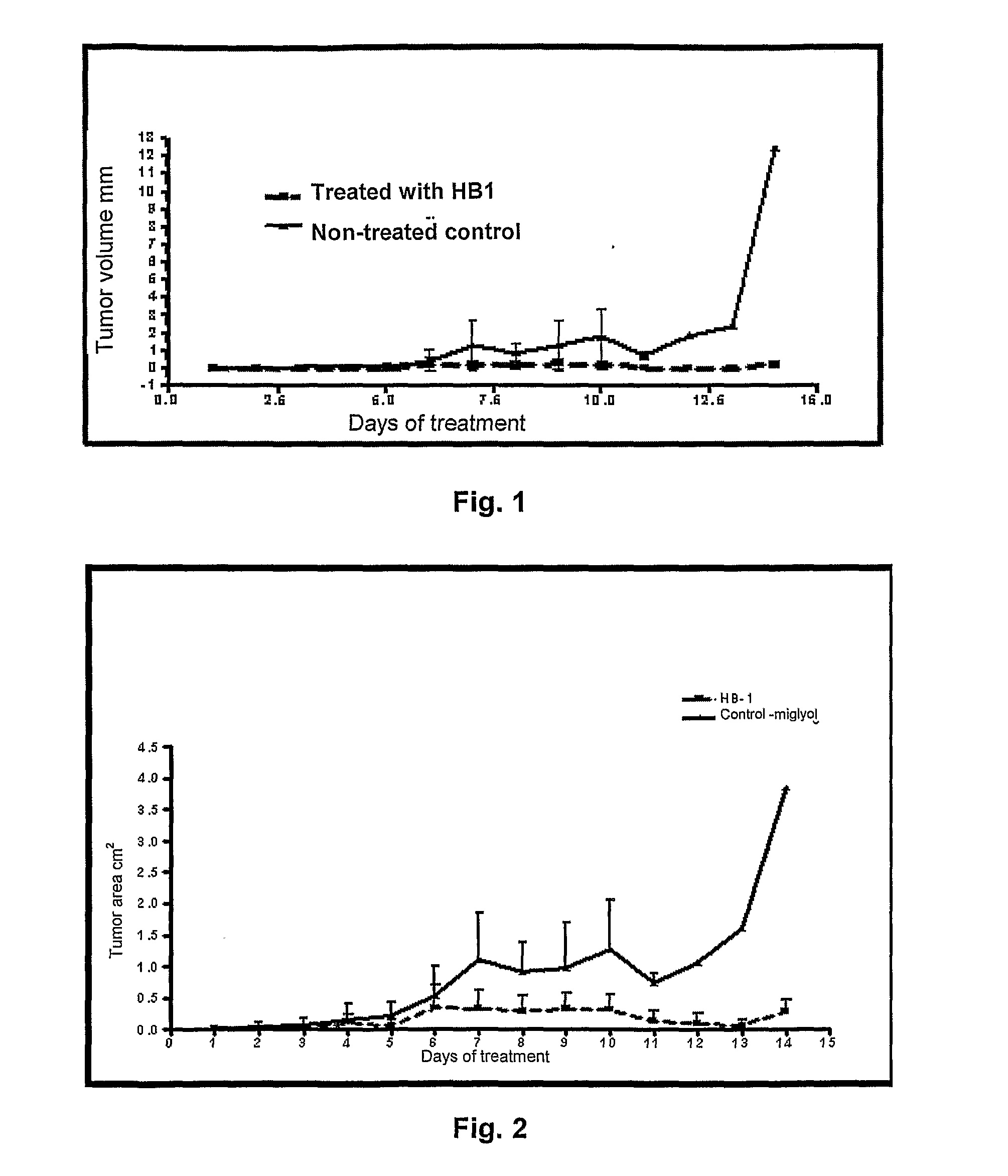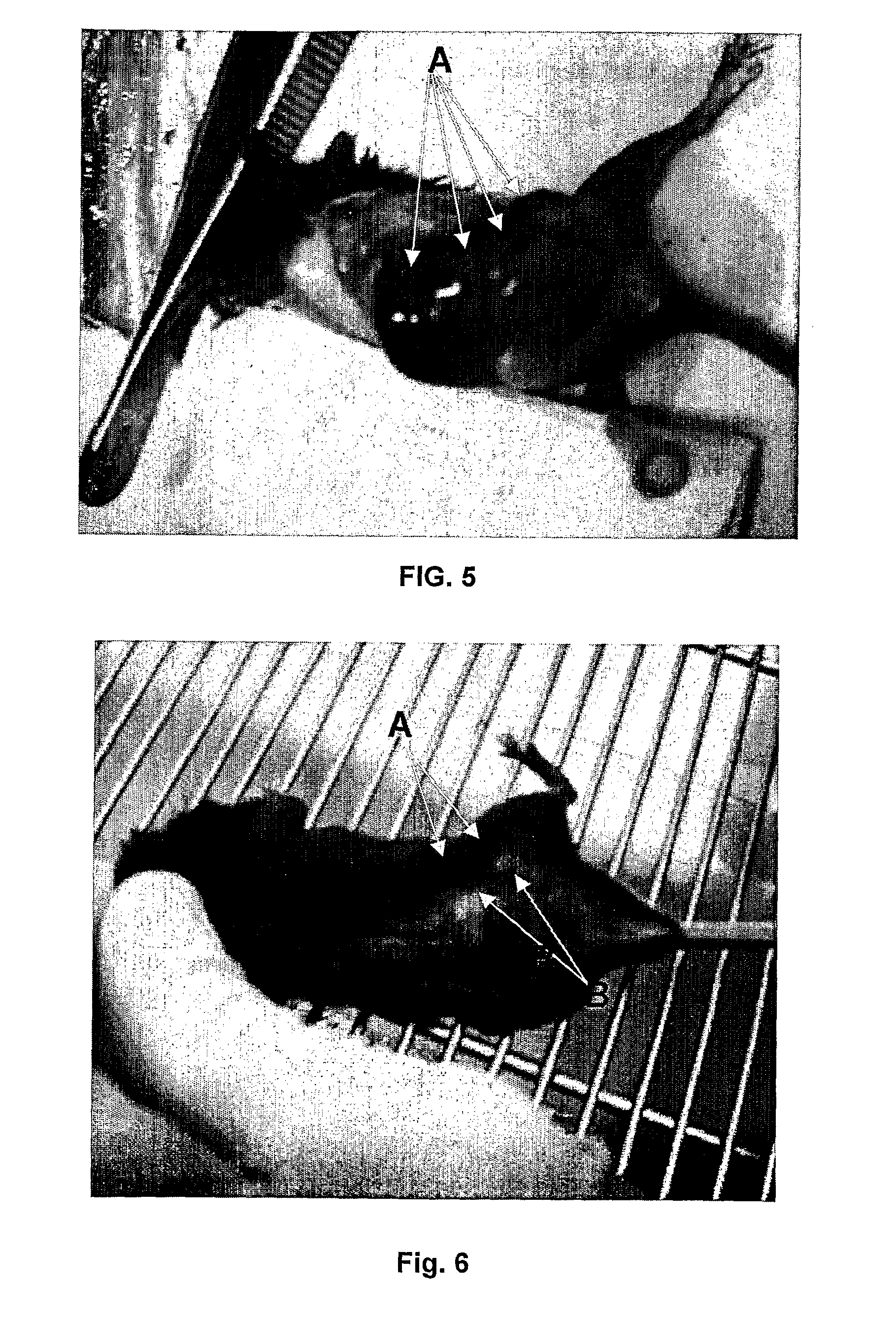Methods to prepare penta-1,4-dien-3-ones and substituted cyclohexanones and derivatives with antitumoral and antiparasitic properties, the compounds and their uses
a technology of penta-1,4-dien-3one and derivatives, which is applied in the preparation of carboxylic compounds, antiparasitic agents, drug compositions, etc., can solve the problems of drug toxicity, parasite resistance, and the decrease of the life quality of patients
- Summary
- Abstract
- Description
- Claims
- Application Information
AI Technical Summary
Problems solved by technology
Method used
Image
Examples
example 1
Preparation of sodium 4-[5-(4-hydroxy-3-methoxy-phenyl)-3-oxo-penta-1,4-dienyl]-2-methoxy-phenolate (codified as DM2)
[0116]
[0117]From 1,5-bis(4-hydroxy-3-methoxy-phenyl)penta-1,4-dien-3-one in the presence of metallic alcoxide in a 1:1 molar ratio. Preferably, 1,5-bis(4-hydroxy-3-methoxy-phenyl)penta-1,4-dien-3-one is mixed with an alcoholic solution of the respective alcoxide, followed by solvent rotoevaporation until solid constitution. Monosalt may be obtained with a high yield. Once obtained, the phenolate is passed through a sieve in order to obtain a fine powder more easily solubilized in water and applied to the biological tests further described in this document.
[0118]The product shows a dark red colour.
[0119]General formula: C19H17O5Na. Molecular weight: 348.
[0120]Yield: 90%.
[0121]Result from Structural Characterization:
[0122]UV-VIS: Maximum absorption 388 nm in water.
[0123]Through acidification with hydrochloric acid, the monosalt is transformed into the correspondent 1,5-...
example 2
Preparation of disodium 3-oxo-penta-1,4-dienyl-bis(2-methoxy-phenolate) codified as DM1)
[0134]
[0135]From the 1,5-bis(4-hydroxy-3-methoxy-phenyl)penta-1,4-dien-3-one in the presence of metallic alcoxide in a 1:2 molar ratio. Preferably, the 1,5-bis(4-hydroxy-3-methoxy-phenyl)penta-1,4-dien-3-one is mixed with an alcoholic solution of the respective alcoxide, followed by a rotoevaporation of the solvent until solid constitution. The disalt can be obtained with high yield. Once prepared, the phenolate is passed though a sieve in order to obtain a fine powder more easily solubilized in water and applied to the biological tests further described in this document.
[0136]The product shows a dark red colour.
[0137]General formula: C19H16O5Na2. Molecular weight: 370.
[0138]Yield: 95%.
[0139]Results from Structural Characterization:
[0140]UV-VIS: Maximum absorption is 370 nm in water.
[0141]Through hydrochloric acid acidification, the correspondent disalt is transformed into the correspondent 1,5-b...
example 3
Preparation of the 3,5-Bis-[3-methoxy-4-(3-methyl-but-2-enyloxy)-phenyl]-4-nitro-cyclohexanone (codified as C-25)
[0142]
Procedure for Preparation A
[0143]Previously, prepare a mixture containing from 5 to 20 mL of dimethylformamide, 1.38 g (0.01 mol) anhydrous potassium carbonate, and 0.01 mol (0.54 mL) of nitromethane, which should be heated under reflux at 20 to 70° C., stirring up for 30 to 60 minutes. After this period of time, add 0.001 mol (540 mg) of the compound 1,5-Bis[3-methoxy-4-(3-methyl-but-2-enyloxy)-phenyl]penta-1,4-dien-3-one dissolved in an appropriated quantity of dimethylformamide and let it heat under stirring for a period of 5 to 15 hours. After this time, the mixture are dropped into water and ice, acidified, extracted with ethyl acetate as required, and the organic phase washed with destined water. Dry with anhydrous sodium sulfate and rotoevaporate the solvent, obtaining the product of reaction.
Procedure for Preparation B
[0144]In this preparation procedure, an ...
PUM
| Property | Measurement | Unit |
|---|---|---|
| temperatures | aaaaa | aaaaa |
| temperatures | aaaaa | aaaaa |
| temperatures | aaaaa | aaaaa |
Abstract
Description
Claims
Application Information
 Login to View More
Login to View More - R&D
- Intellectual Property
- Life Sciences
- Materials
- Tech Scout
- Unparalleled Data Quality
- Higher Quality Content
- 60% Fewer Hallucinations
Browse by: Latest US Patents, China's latest patents, Technical Efficacy Thesaurus, Application Domain, Technology Topic, Popular Technical Reports.
© 2025 PatSnap. All rights reserved.Legal|Privacy policy|Modern Slavery Act Transparency Statement|Sitemap|About US| Contact US: help@patsnap.com



